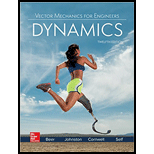
Concept explainers
Three identical cars are being unloaded from an automobile carrier. Cars B and C have just been unloaded and are at rest with their brakes off when car A leaves the unloading ramp with a velocity of 5 .76 ft/s and hits car B, which hits car C. Car A then again hits car B. Knowing that the velocity of car B is 5.04 ft/s after the first collision. 0.630 ft/s after the second collision, and 0.709 ft/s after the third collision, determine (a) the final velocities of cars A and C, (b) the coefficient of restitution for each of the collisions.

The final velocities of the car A and C.
Answer to Problem 14.105RP
The value of final velocities of the car A is VA = 0.641ft/s and for car C is Vc=4.41ft/s
Explanation of Solution
Given information:
Based on the principle of impulse momentum system before impact and after impact is same and equal
First consider the momentum of the car A hits car B at first time:
And then consider the momentum when the car B hits car C we get
Formulate the momentum when car A hits car B for second consideration
The coefficient of restitution for each of the collision.
Answer to Problem 14.105RP
The value of coefficient of restitution is e1 = 0.75, e2=0.75, e3=0.75
Explanation of Solution
Here the coefficient of restitution is a difference between relative velocities to the after and before impact.
First, we must formulate the coefficient of restitution when the condition is A hits B for first consideration.
Similarly formulate coefficient of resolution the condition is B hits C, we get:
Formulate the coefficient of resolution then consider A hits B for the second consideration.
Want to see more full solutions like this?
Chapter 14 Solutions
VECTOR MECH...,DYNAMICS(LOOSE)-W/ACCESS
- Draw top, side, front view With pen(cil) and paper Multi view drawing and handwriting all of itarrow_forwardA wheel of diameter 150.0 mm and width 37.00 mm carrying a load 2.200 kN rolls on a flat rail. Take the wheel material as steel and the rail material as cast iron. Assume the figure given, which is based on a Poisson's ratio of 0.3, is applicable to estimate the depth at which the maximum shear stress occurs for these materials. At this critical depth, calculate the Hertzian stresses σr, σy, σz, and Tmax for the wheel. 1.0 0.8 0, т Ratio of stress to Pmax 0.4 0.6 90 69 0.2 0.5b b 1.5b Tmax 2b Distance from contact surface The Hertizian stresses are as follows: 02 = or = -23.8 psi for the wheel =| necessary.) σy for the wheel =| MPa σz for the wheel = MPa V4 for the wheel = | MPa 2.5b ཡི 3b MPa (Include a minus sign ifarrow_forwardOnly question 3arrow_forward
- In cold isostatic pressing, the mold is most typically made of which one of the following: thermosetting polymer tool steel sheet metal textile rubberarrow_forwardThe coefficient of friction between the part and the tool in cold working tends to be: lower higher no different relative to its value in hot workingarrow_forwardThe force F={25i−45j+15k}F={25i−45j+15k} lblb acts at the end A of the pipe assembly shown in (Figure 1). Determine the magnitude of the component F1 which acts along the member AB. Determine the magnitude of the component F2 which acts perpendicular to the AB.arrow_forward
 Elements Of ElectromagneticsMechanical EngineeringISBN:9780190698614Author:Sadiku, Matthew N. O.Publisher:Oxford University Press
Elements Of ElectromagneticsMechanical EngineeringISBN:9780190698614Author:Sadiku, Matthew N. O.Publisher:Oxford University Press Mechanics of Materials (10th Edition)Mechanical EngineeringISBN:9780134319650Author:Russell C. HibbelerPublisher:PEARSON
Mechanics of Materials (10th Edition)Mechanical EngineeringISBN:9780134319650Author:Russell C. HibbelerPublisher:PEARSON Thermodynamics: An Engineering ApproachMechanical EngineeringISBN:9781259822674Author:Yunus A. Cengel Dr., Michael A. BolesPublisher:McGraw-Hill Education
Thermodynamics: An Engineering ApproachMechanical EngineeringISBN:9781259822674Author:Yunus A. Cengel Dr., Michael A. BolesPublisher:McGraw-Hill Education Control Systems EngineeringMechanical EngineeringISBN:9781118170519Author:Norman S. NisePublisher:WILEY
Control Systems EngineeringMechanical EngineeringISBN:9781118170519Author:Norman S. NisePublisher:WILEY Mechanics of Materials (MindTap Course List)Mechanical EngineeringISBN:9781337093347Author:Barry J. Goodno, James M. GerePublisher:Cengage Learning
Mechanics of Materials (MindTap Course List)Mechanical EngineeringISBN:9781337093347Author:Barry J. Goodno, James M. GerePublisher:Cengage Learning Engineering Mechanics: StaticsMechanical EngineeringISBN:9781118807330Author:James L. Meriam, L. G. Kraige, J. N. BoltonPublisher:WILEY
Engineering Mechanics: StaticsMechanical EngineeringISBN:9781118807330Author:James L. Meriam, L. G. Kraige, J. N. BoltonPublisher:WILEY





